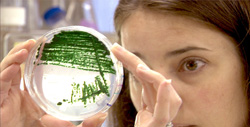Study Finds Bacteria Divide Like Clockwork
MARCH 5, 2001
Media Contact: Kim McDonald (858) 534-7572
Jen Hirsch 858-534-7572
Written by Anne Trafton and Kim McDonald

A researcher in Susan Golden’s UCSD lab examines colonies of cyanobacteria.
Credit: Susan Golden Lab, UCSD
A team of researchers from UC San Diego and MIT has shown how cell division in a type of bacteria known as cyanobacteria is controlled by the same kind of circadian rhythms that govern human sleep patterns.
The scientists' findings are detailed in paper in the March 19 issue of the journal Science.
Previous studies have shown that even though cyanobacteria do not "sleep" in the same way that humans do, they cycle through active and resting periods on a 24-hour schedule. Cyanobacteria depend on sunlight for photosynthesis, so they are most active during the day.

Cell division in colonies of cyanobacteria is controlled by the same kind of circadian rhythms that govern human sleep patterns.
Credit: Susan Golden Lab, UCSD
The UCSD and MIT researchers demonstrated, for the first time, how the circadian clock regulates the bacteria's rate of cell division (their method of reproduction) in single cells. "These cells have to keep dividing, and the circadian oscillator regulates when they divide," said Bernardo Pando, an MIT graduate student in physics and one of the lead authors of the paper in Science.
In multi-cellular animals, including humans, cell division is critical for renewal and repair, while out-of-control cell division leads to cancer. "Understanding how cells are dividing is really of fundamental importance," said Susan Golden, a professor of biology at UCSD, a senior author of the paper and co-director of UCSD's new Center for Chronobiology, a campus-wide research center that is applying discoveries about the biological clocks of bacteria and other organisms to humans.
The discovery follows another recently published by Golden and her colleagues at UCSD, MIT, Michigan State University and Texas A&M University in the February 19 issue of the journal Cell. In that discovery, the researchers unraveled the biochemistry of how cyanobacteria so precisely time cell division, a key element in understanding how all organisms from bacteria to humans use their biological clocks to control basic cellular functions.
Cyanobacteria maintain their circadian rhythms even when isolated from the naturally occurring daily light-dark cycles of the sun, just as humans do. The researchers found that under conditions of moderate constant light, the cyanobacteria undergo cell division about once per day, and the divisions take place mostly at the midpoint of the 24-hour cycle
To figure out how the cell division cycle is coupled to the circadian clock, the researchers sped up the cell cycle by boosting the intensity of light, enabling the cells to photosynthesize more, which increases the amount of energy available to them. The cells did start to divide more frequently, but in a pattern still linked to the circadian clock - they divided once a quarter of the way into the cycle, and again three-quarters into the cycle.
The team also showed that the cyanobacteria enter a resting phase about 19 hours into the circadian cycle, after which they will not divide until the next cycle begins.
The researchers tracked single cells over a weeklong period. Proteins that govern the circadian clock were tagged with yellow fluorescent protein, so each cell's position in the 24-hour cycle could be pinpointed. Cells were also photographed every 40 minutes, so researchers could see when they divided.
This is the first time researchers have studied how cell cycle and circadian rhythms are coupled in individual bacterial cells. "You can only do this by looking at single cells," said Alexander van Oudenaarden, a professor of biophysics at MIT and a senior author of the paper.
The same experimental setup could be used to study the relationship between circadian clocks and any other cell function that oscillates periodically. Yeast and mammalian cells are logical targets for such studies, says van Oudenaarden. Golden and her UCSD colleagues are planning further studies into how the circadian clock and proteins that control cell division in cyanobacteria are linked.
Funding for the project was provided by the National Science Foundation and National Institutes of Health.
